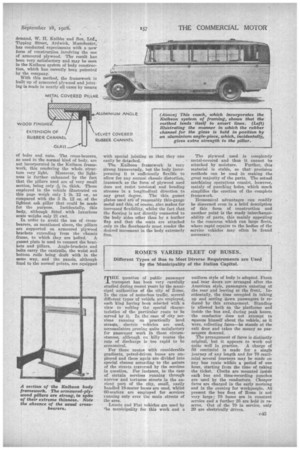ROME'S VARIED FLEET OF BUSES.
Page 29

If you've noticed an error in this article please click here to report it so we can fix it.
Different Types of Bus to Meet Diverse Requirements are Used by the Municipality of the Italian Capital.
THE question of public passenger transport has been very carefully studied daring recent years by the municipal authorities of the city of home. In the ease of motorbus traffic, several different types of vehicle are employed, each kind having been selected with a view to suiting the special charaeteristies of the particular route to be served by it. In the case of city services running on practically level streets, electric vehicles are used, accumulators proving quite satisfactory for passenger work" in these circumstances, although on hilly routes the rate of discharge is too rapid to be economical.
For those routes with c.onsiderabie gradients, petrol-driven buses are employed and these again are divided into special classes according to the nature of the streets traversed by the services in question. For instance, in the case of certain services running through narrow and tortuous streets in the ancient part of the city, small, easily handled 18-seater buses are used, whilst 60-seaters are employed for services running only over the main streets of the area.
• Lancia and Fiat vehicles are used by 'he municipality for this work and a
uniform style of body is adopted. Front and rear doors are arranged after the American style, passengers entering at the rear and leaving at the front. IIIeidentally, the time occupied in taking up and setting down passengers is reduced by this arrangement. Standing is allowed both on the platforms and inside the bus and, during peak hears, the conductor does not attempt to squeeze himself about the vehicle, as it were, collecting fares—he stands at the exit door and takes the money as passengers descend.
The arrangement of fares is distinctly original, but it appears to work out
quite well in practice. A charge of 50 centimini is made for a single journey of any length and for 70 centimini several journeys may be made on any bus route within a period of one hour, starting from the time of taking the ticket. Clocks are mounted inside each bus and time-recording punches are used by the conductors. Cheaper fares are charged in the early morning and in the evening for workpeople. At present the bus fleet of Rome is not very large; 70 buses are in constant service and a further 25 are held in reserve. Out of the 70 in service, only 20 are electrically driven.
































